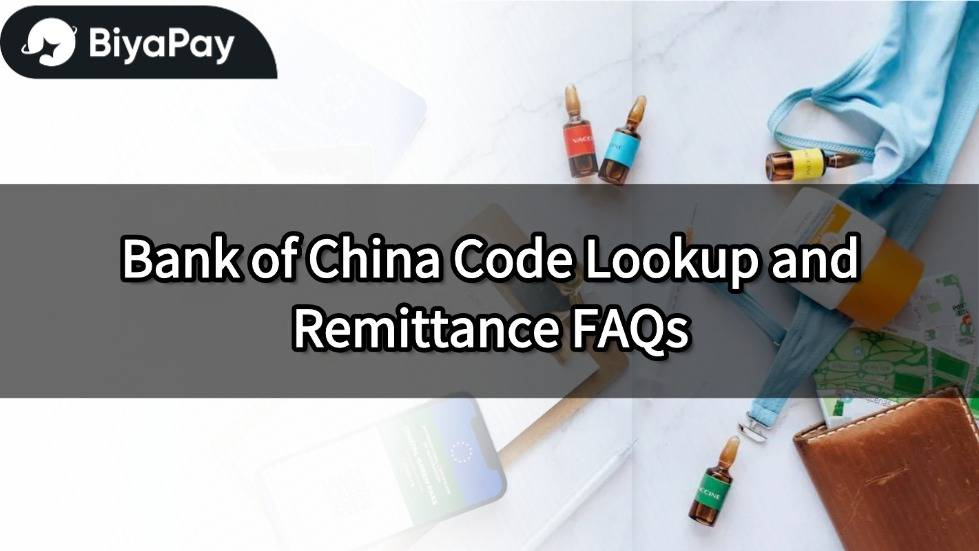- EasyCard
- Trade
- Help
- Announcement
- Academy
- SWIFT Code
- Iban Number
- Referral
- Customer Service
- Blog
- Creator
Bank of China Code Lookup and Remittance FAQs

Image Source: pexels
Have you ever wondered how to look up Bank of China codes? What’s the difference between a SWIFT Code and a local bank code when making a remittance? Many people often get remittance details wrong, leading to increased fees or delayed funds. You can use official lookup links to ensure you fill in the details correctly each time, reducing the chance of errors.
Key Highlights
- Use official websites or bank resources to look up Bank of China codes, ensuring remittance details are accurate, reducing errors and delay risks.
- International remittances require the correct SWIFT Code and recipient details, while local remittances need the local bank code and account number, with different uses for each.
- When making a remittance, carefully verify the bank code, recipient’s name, and account number to avoid errors that could lead to funds being returned or extra fees.
- Electronic remittance platforms like Wise and OFX offer lower fees and faster transfer speeds, serving as good alternatives to traditional banks.
- If you encounter remittance issues, contact bank customer service immediately and keep all remittance receipts for easy tracking and problem resolution.
Bank of China Code Lookup

Image Source: pexels
SWIFT Code and BIC Code
When making international remittances, you often encounter SWIFT Code or BIC Code. These two names actually refer to the same bank identification code. The SWIFT Code, managed by the SWIFT organization, is a unique identifier for banks and financial institutions worldwide. You need this code to ensure funds are accurately delivered to the recipient bank.
A SWIFT Code generally consists of 8 to 11 characters, divided into the following parts:
- Bank code (4 letters)
- Country code (2 letters, based on ISO 3166-1 standard)
- Location code (2 letters or numbers)
- Branch code (optional, 3 letters or numbers)
Tip: When filling out an international remittance form, you must provide the recipient bank’s SWIFT Code and the recipient’s account number, otherwise the funds may not be credited correctly.
The SWIFT Code is mainly used for international remittances and cross-border financial transactions. You cannot use a SWIFT Code for local bank transfers within Hong Kong.
Local Bank Code
The local bank code is a numerical code used within Hong Kong’s banking system to identify different banks. You often need to fill in this code when making local transfers, paying bills, or setting up automatic transfers. Each bank has a unique local bank code, for example:
| Bank Name | Local Bank Code |
|---|---|
| Bank of China (Hong Kong) | 012 |
| The Hongkong and Shanghai Banking Corporation | 004 |
| Hang Seng Bank | 024 |
You should note that the local bank code is only applicable for transactions between banks in Hong Kong and cannot be used for international remittances.
Lookup Methods and Official Links
You can use multiple methods to look up Bank of China codes to ensure the details are correct:
- Visit the Ministry of Finance website (https://www.mof.gov.tw/), which is the main official resource for looking up bank codes. This website provides services such as financial and trade statistics, regulation inquiries, announcements, and statistical databases.
- On the Ministry of Finance website, you can find categories like “Financial and Trade Statistics,” “Statistical Publications,” and “Related Statistical Websites.” These categories include annually updated statistical data, and while there may not be specific annual statistics for Bank of China codes, you can review the latest bank codes and related information.
- You can also refer to the official websites of major banks, which typically list their own and other banks’ local bank codes and SWIFT Codes under “Customer Service” or “FAQs” pages.
- If you need the latest bank codes or have questions, it’s recommended to directly call the bank’s hotline for inquiries.
Tip: When looking up Bank of China codes, you should prioritize using official websites or resources provided by banks, avoiding unverified third-party websites to prevent outdated or incorrect information.
Looking up Bank of China codes is crucial for ensuring smooth remittances. By making good use of official links and resources, you can significantly reduce the risk of filling in incorrect details.
Remittance Details and Process

Image Source: unsplash
International Remittance Required Details
When making an international remittance, you must prepare a series of details. The completeness and accuracy of these details are very important. According to financial institutions’ operational procedures, banks will strictly review your application to ensure every detail is correct. The main details you need to fill in include:
- Recipient’s name (must match the bank account registration)
- Recipient bank’s name and address
- Recipient bank’s SWIFT Code
- Recipient bank’s account number
- Remittance amount (in USD or other specified currency)
- Purpose of remittance
- Remitter’s contact information
The bank will enter the details into the international balance of payments system within the next business day after you submit the application. If there are errors in the details, the bank will ask you to correct them. You should keep all application documents properly, as banks will retain them for at least 24 months and accept audits by regulatory authorities. This process ensures the completeness and accuracy of international remittance details.
Tip: When filling in the SWIFT Code and recipient’s name, you must ensure they exactly match the bank’s registered details. Any errors in the details could lead to remittance delays or returns, potentially incurring additional fees.
Local Remittance Required Details
When making local remittances in Hong Kong, the required details are relatively simple but still need to be filled in accurately. Common local remittance methods include Faster Payment System (FPS), bank counter transfers, and automatic transfers. You typically need to provide the following details:
- Recipient’s name
- Recipient bank’s name
- Recipient bank’s account number
- Local bank code (e.g., Bank of China (Hong Kong) is 012)
- Remittance amount (in USD or HKD, depending on the bank’s exchange rate)
- Purpose of remittance (e.g., bill payment, transfer, etc.)
When using FPS, you can also use a mobile number or email address as the recipient identifier. You must ensure all details are correct, otherwise it may lead to delays or returns of funds.
Note: Local remittances do not require a SWIFT Code, but you must fill in the correct local bank code and account number. You can check the latest bank codes on the bank’s official website.
IBAN, UETR, and Other Identification Codes
When making international remittances, besides the SWIFT Code, you may encounter other identification codes. These codes help improve the accuracy and tracking efficiency of remittances.
| Identification Code Type | Purpose | Description |
|---|---|---|
| IBAN | Bank account number in Europe and some countries | Composed of multiple letters and numbers to ensure accurate cross-border remittances |
| UETR | International remittance tracking number | Each international remittance generates a unique UETR for tracking fund flows |
| ABA | U.S. bank code | Used for remittances within the U.S., similar to a local bank code |
| FPS Identifier | Hong Kong local FPS identifier | Can use mobile number, email, or FPS ID as recipient identifier |
When remitting to Europe, banks will require you to provide an IBAN. For U.S. remittances, an ABA number is needed. The UETR is a new standard for international remittances, with each remittance automatically generating a UETR number. You can use this number to check the remittance progress with the bank.
Tip: When filling in these identification codes, you should refer to examples and instructions provided by the bank. Any errors in the details will affect the timeliness and security of the remittance.
During the remittance process, banks will track data error rates based on indicators in the Tag72 field. If the recipient’s name, account number, or SWIFT Code is incorrect, the bank will record it and ask you to correct it. These measures help improve overall remittance accuracy and reduce the risk of fund delays.
Remittance Notes
Common Errors
When making remittances, you often encounter the following errors:
- Incorrect bank code or SWIFT Code
- Recipient’s name does not match bank registration
- Account number has missing or extra digits
- Purpose of remittance is not filled in or unclear
- Wrong recipient bank branch selected
Tip: Each time you fill in remittance details, you should cross-check with the bank’s official website or call customer service to confirm. This can reduce data errors and avoid fund delays.
Solutions
When you discover errors in remittance details, you can take the following steps:
- Immediately contact your bank’s customer service and explain the error.
- Provide the correct recipient details and remittance proof.
- If the funds have been returned, the bank will assist you in reprocessing the remittance.
- If the remittance is still in progress, the bank can help correct the details or cancel the transaction.
Note: You should keep all remittance receipts and confirmation emails. These documents help the bank track and resolve issues.
Fees and Timeliness
When making international remittances, you should pay attention to the following points:
| Item | Description |
|---|---|
| Fees | Hong Kong banks’ international remittance fees are generally USD 20-50, depending on the bank and remittance amount. |
| Exchange Rate | Banks calculate the amount based on the day’s USD-to-target-currency exchange rate during remittance. |
| Arrival Time | International remittances typically take 1-3 business days; local remittances (e.g., FPS) can arrive instantly. |
| Remittance Limit | Different banks have caps on single and daily remittances, commonly USD 10,000-50,000. |
| Cancellation and Changes | If a remittance is completed, cancellation or changes depend on the recipient bank’s processing progress and may incur additional fees. |
Tip: Before making a remittance, you should check the latest fees and exchange rates. For urgent needs, consider using instant remittance services, but fees may be higher.
Other Remittance Methods
Electronic Remittance Platforms
You can choose electronic remittance platforms to handle international transfers. These platforms include Wise, OFX, and PayPal. They offer a simple and fast remittance experience. You only need to register an account online, enter the recipient’s details and amount, and the platform will automatically calculate the exchange rate and fees.
The main advantages of electronic remittance platforms include:
- Lower fees: Wise and OFX fees are generally lower than traditional banks, typically around USD 5-15, depending on the amount and destination.
- Transparent exchange rates: Platforms display real-time exchange rates, letting you know the exact amount received.
- Fast processing: Some platforms complete remittances within 1-2 business days, sometimes even instantly.
- Convenient operation: You can make remittances anytime, anywhere via mobile or computer.
Tip: When choosing an electronic remittance platform, you should compare fees and exchange rates across platforms and confirm whether the platform supports your required countries and currencies.
Traditional Banks vs. New Services Comparison
When choosing a remittance method, you can refer to the following comparison:
| Item | Traditional Banks (e.g., Hong Kong Banks) | Electronic Remittance Platforms (e.g., Wise, OFX, PayPal) |
|---|---|---|
| Fees | USD 20-50 | USD 5-15 |
| Exchange Rate | Bank-set, higher spread | Real-time rate, lower spread |
| Arrival Time | 1-3 business days | Fastest instant, typically 1-2 business days |
| Operation Method | Counter, online banking | Online platform, mobile app |
| Tracking Service | Requires contacting bank | Platform shows real-time progress |
You can choose the most suitable remittance method based on your needs. If you value speed and cost, electronic remittance platforms are a better choice. For large amounts or special-purpose remittances, traditional banks offer more security.
Note: Before using any remittance service, you should verify all details and keep transaction records to ensure fund safety.
When looking up Bank of China codes and making remittances, you should carefully verify all details to ensure the bank code is correct. Official websites update data quarterly and upload the latest content instantly, providing you with accurate information. If you have questions, please proactively contact the bank to ensure fund safety.
- Official websites publish the latest data quarterly, and correct publication times instantly.
- Data is synchronized to relevant units, ensuring timeliness and accuracy.
- You should make good use of official lookup links to reduce error risks.
FAQ
How do you look up the SWIFT Code for Bank of China (Hong Kong)?
You can check the SWIFT Code on the Bank of China (Hong Kong) official website. You can also call the customer service hotline or visit a branch in person to confirm the details are correct.
What happens if you fill in the wrong bank code during a remittance?
If you fill in the wrong bank code, the bank may return the funds. You will need to resubmit the correct details and may have to pay additional fees.
Do international remittances require an IBAN?
When remitting to Europe or certain countries, banks will require you to provide an IBAN. You should confirm the correct IBAN with the recipient to ensure funds arrive smoothly.
Does FPS remittance require a SWIFT Code?
When using FPS for local remittances, you don’t need a SWIFT Code. You only need to provide the recipient’s bank code, account number, or mobile number.
How are remittance fees calculated?
When you make a remittance, banks charge fees based on the amount and destination. For Hong Kong banks, international remittance fees are generally USD 20-50, depending on the exchange rate and service.
Ensuring accurate bank codes and remittance details is crucial, but are high international transfer fees and delays causing frustration? BiyaPay offers a seamless alternative! Trade US and Hong Kong stocks directly without offshore accounts, capitalizing on market opportunities effortlessly. Benefit from a 5.48% annualized yield savings product with flexible withdrawals.
Real-time exchange rate tracking supports conversions between USD, HKD, and over 30 fiat currencies with USDT, while remittances to 190+ countries start at just 0.5% in fees, arriving swiftly. Join BiyaPay today to streamline your global transactions with ease!
*This article is provided for general information purposes and does not constitute legal, tax or other professional advice from BiyaPay or its subsidiaries and its affiliates, and it is not intended as a substitute for obtaining advice from a financial advisor or any other professional.
We make no representations, warranties or warranties, express or implied, as to the accuracy, completeness or timeliness of the contents of this publication.




Contact Us
Company and Team
BiyaPay Products
Customer Services
is a broker-dealer registered with the U.S. Securities and Exchange Commission (SEC) (No.: 802-127417), member of the Financial Industry Regulatory Authority (FINRA) (CRD: 325027), member of the Securities Investor Protection Corporation (SIPC), and regulated by FINRA and SEC.
registered with the US Financial Crimes Enforcement Network (FinCEN), as a Money Services Business (MSB), registration number: 31000218637349, and regulated by FinCEN.
registered as Financial Service Provider (FSP number: FSP1007221) in New Zealand, and is a member of the Financial Dispute Resolution Scheme, a New Zealand independent dispute resolution service provider.



















